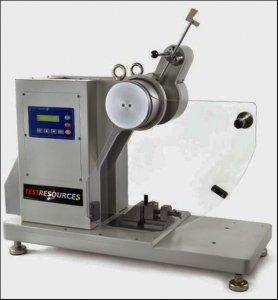
An impact test is used to observe the mechanics that a material will exhibit when it experiences a shock loading that causes the specimen to immediately deform, fracture or rupture completely. To perform this test the sample is placed into a holding fixture with the geometry and orientation determined by the type of test that is used and then a known weight generally but not always in the shape of a pendulum is released from a known height so that it collides with the specimen with a sudden force. This collision between the weight and specimen generally results in the destruction of the specimen but the transfer of energy between the two is used to determine the fracture mechanics of the material.
Purpose of impact testing:
The purpose of an impact test is to determine the ability of the material to absorb energy during a collision. This energy may be used to determine the toughness, impact strength, fracture resistance, impact resistance or fracture resistance of the material depending on the test that was performed and the characteristic that is to be determined. These values are important for the selection of materials that will be used in applications that require the material to undergo very rapid loading processes such as in vehicular collisions.
Types of impact tests:
For a single impact test the three most popular types of test are the Charpy V-notch test, the Izod test and the Tensile Impact test. These three tests all essentially determine the same characteristics of the material but differ in the orientation of the test sample which causes the sample to be stressed in different directions and involve a known weight released from a known height colliding with the specimen in its test fixture. All of these tests are useful in determining the impact mechanics of the test specimen.
Types of materials for impact testing:
Nearly all materials may benefit from impact testing, but the most common types used are metals, plastics, woods, composites, ceramics, and polymers. Generally these materials take the form of sheets of varying thicknesses or short rods depending on the test. However, most materials will experience either ductile or brittle failure depending of the type of test, the rate of loading and the temperature of the sample. Brittle failure of a material requires a small amount of energy to begin the crack or to cause the crack to grow until the sample fails. On the other hand, ductile failure of a material requires a much higher load to initiate and propagate the crack until failure.
Selected Test Standards
- ASTM D1822 Tensile Impact Energy of Plastic | Test Machines & Equipment
- ASTM D256 Izod Impact Resistance of Plastics
- ASTM D4812 Unnotched Pendulum Impact of Plastic Test Machine
- ASTM D6110 Charpy Impact Resistance of Notched Specimens of Plastics
- ISO 13802 Pendulum Impact Test of Plastics | Machines
- ISO 179 Charpy Impact Strength of Notched Plastics | Testing Equipment
- ISO 180 Izod Impact Strength of Plastic | Test Equipment
- ISO 7765-1 Impact Resistance of Plastic Sheet and Film | Testing Equipement
- ISO 8256 Tensile Impact of Plastics Test Equipment
